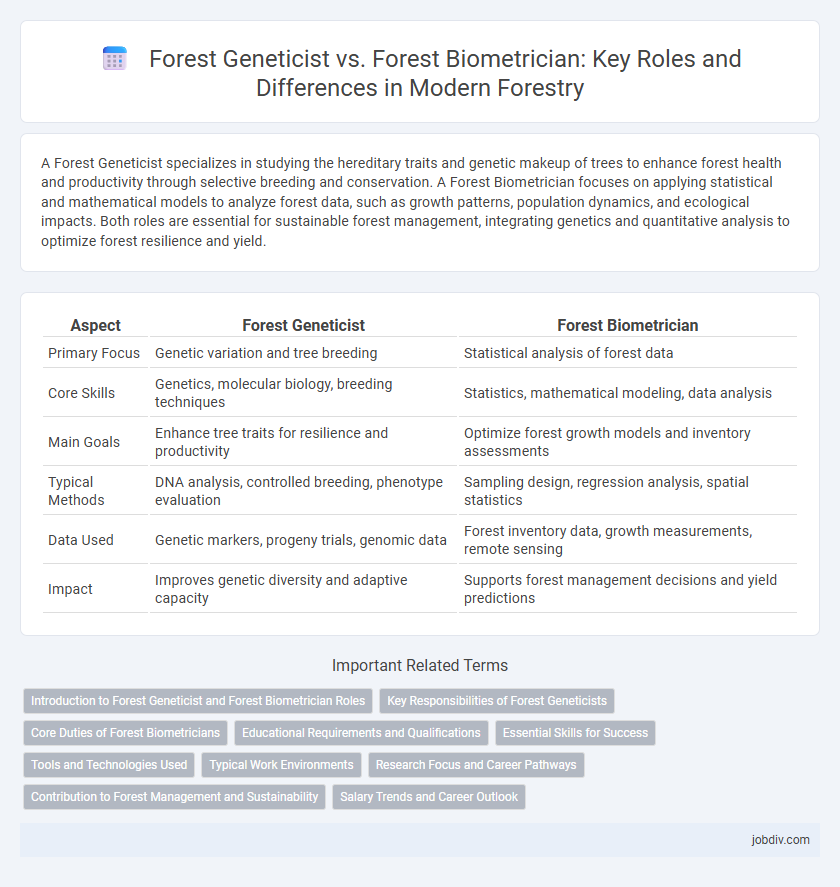A Forest Geneticist specializes in studying the hereditary traits and genetic makeup of trees to enhance forest health and productivity through selective breeding and conservation. A Forest Biometrician focuses on applying statistical and mathematical models to analyze forest data, such as growth patterns, population dynamics, and ecological impacts. Both roles are essential for sustainable forest management, integrating genetics and quantitative analysis to optimize forest resilience and yield.
Table of Comparison
| Aspect | Forest Geneticist | Forest Biometrician |
|---|---|---|
| Primary Focus | Genetic variation and tree breeding | Statistical analysis of forest data |
| Core Skills | Genetics, molecular biology, breeding techniques | Statistics, mathematical modeling, data analysis |
| Main Goals | Enhance tree traits for resilience and productivity | Optimize forest growth models and inventory assessments |
| Typical Methods | DNA analysis, controlled breeding, phenotype evaluation | Sampling design, regression analysis, spatial statistics |
| Data Used | Genetic markers, progeny trials, genomic data | Forest inventory data, growth measurements, remote sensing |
| Impact | Improves genetic diversity and adaptive capacity | Supports forest management decisions and yield predictions |
Introduction to Forest Geneticist and Forest Biometrician Roles
Forest geneticists study the hereditary traits of trees to improve forest resilience, productivity, and adaptation through selective breeding and genetic analysis. Forest biometricians specialize in the quantitative measurement and analysis of forest data, applying statistical methods to assess forest growth, health, and resources. Both roles are crucial for sustainable forest management, with geneticists focusing on tree genetics and biometricians on data-driven forest monitoring.
Key Responsibilities of Forest Geneticists
Forest geneticists specialize in studying the hereditary traits and genetic variation within tree populations to improve forest biodiversity and resilience. They analyze genetic markers to develop breeding programs that enhance disease resistance, growth rates, and adaptability to environmental changes. Their work involves collecting DNA samples, conducting genetic mapping, and collaborating with ecologists to implement sustainable forest management practices.
Core Duties of Forest Biometricians
Forest biometricians specialize in quantifying forest attributes by applying statistical methods and mathematical models to analyze data on tree growth, forest composition, and ecosystem dynamics. Their core duties include designing and implementing forest inventories, developing growth and yield models, and utilizing remote sensing technologies to monitor forest health and carbon stocks. These professionals collaborate closely with forest geneticists to integrate genetic variation data into predictive models for sustainable forest management.
Educational Requirements and Qualifications
Forest geneticists typically require a bachelor's degree in forestry, genetics, or biology, often followed by a master's or doctoral degree specializing in forest genetics to understand heredity and genetic diversity in tree populations. Forest biometricians usually hold degrees in forestry, statistics, mathematics, or computer science, with advanced studies emphasizing statistical modeling and data analysis applied to forest inventory and growth measurement. Both professions demand strong analytical skills, but forest geneticists focus more on molecular techniques and breeding, while biometricians prioritize quantitative methods and statistical software expertise.
Essential Skills for Success
Forest geneticists require expertise in molecular biology, population genetics, and quantitative genetics to analyze genetic variation and improve tree breeding programs, while forest biometricians specialize in statistical analysis, data modeling, and spatial statistics to interpret forest data accurately. Both professionals must possess strong skills in data collection, software proficiency like R or SAS, and fieldwork techniques, but geneticists emphasize genetics lab techniques whereas biometricians focus more on advanced statistical methodologies. Mastery in GIS and remote sensing technology is also crucial for biometricians to assess forest dynamics, supporting effective forest management decisions.
Tools and Technologies Used
Forest geneticists utilize molecular markers such as microsatellites and single nucleotide polymorphisms (SNPs) alongside genome sequencing technologies to analyze tree genetics and improve breeding programs. Forest biometricians employ statistical software like R, SAS, and specialized forestry tools such as REML (Restricted Maximum Likelihood) and spatial analysis GIS platforms to model growth, yield, and stand dynamics. Both professionals increasingly integrate remote sensing data and drone technology to enhance precision in forest monitoring and genetic trait mapping.
Typical Work Environments
Forest geneticists primarily conduct research in laboratories and field stations, analyzing genetic variation and tree populations to enhance forest breeding programs. Forest biometricians often work in offices and remote field sites, utilizing statistical models and software to interpret forest inventory data and growth patterns. Both professionals collaborate with forestry departments, research institutions, and environmental agencies to support sustainable forest management.
Research Focus and Career Pathways
Forest geneticists specialize in studying the hereditary traits and genetic variation within tree populations to improve forest resilience and productivity. Forest biometricians focus on applying statistical and mathematical models to analyze forest data for monitoring growth, assessing health, and optimizing resource management. Career pathways for forest geneticists often lead to research roles in genetics labs or conservation programs, while forest biometricians typically pursue positions in data analysis, forest inventory, and ecological modeling.
Contribution to Forest Management and Sustainability
Forest geneticists enhance forest management and sustainability by improving tree populations through selective breeding, genetic conservation, and adaptation to environmental stressors, ensuring long-term ecosystem resilience. Forest biometricians contribute by developing and applying quantitative methods to analyze forest growth, yield, and health data, enabling precise decision-making for sustainable resource utilization. Their combined efforts optimize forest productivity while maintaining biodiversity and ecological balance.
Salary Trends and Career Outlook
Forest geneticists typically earn between $60,000 and $90,000 annually, with salaries rising due to increased demand for sustainable forest management and genetic conservation. Forest biometricians often command higher salaries, ranging from $70,000 to $100,000, driven by their expertise in statistical modeling and data analysis critical to forest resource management. Career outlooks for both roles are positive, with growth fueled by advances in technology, climate change research, and the forestry sector's emphasis on data-driven decision-making.
Forest Geneticist vs Forest Biometrician Infographic

 jobdiv.com
jobdiv.com